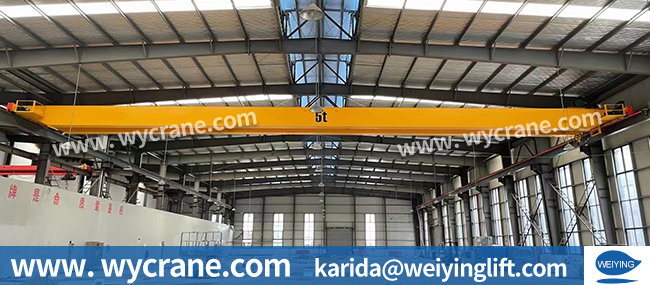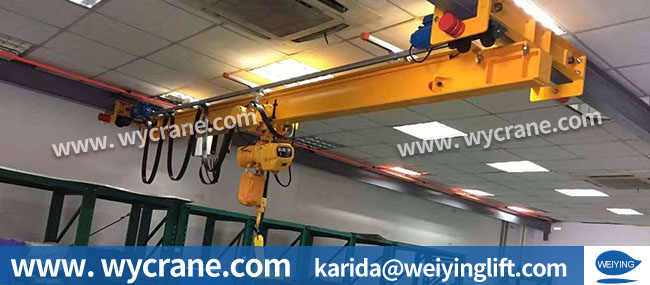Torn Between Top Running Overhead Cranes and Under Running Overhead Cranes? One Excels at Heavy-Duty Operations, the Other Shines in Flexibility and Space-Saving! This Article Breaks Down Their Differences + Key Equipment-Selection Tips to Help Enterprises Pick the Right Equipment.
A top running overhead crane, more commonly referred to in the industry as an overhead bridge crane, is a main force in industrial heavy-duty operations. Its core design feature lies in that the crane’s bridge structure (main beam) moves along the top of elevated track beams, and the beams supporting these tracks are usually fixed by the load-bearing columns of the workshop or independently built steel support structures. Simply put, it is like a movable bridge that travels on overhead tracks, covering a large operating area below. It is particularly suitable for crossing obstacles or covering the entire workshop.

Top running overhead cranes are designed to handle heavy-duty and high-difficulty operations, so their application scenarios are highly concentrated in industrial fields requiring high load capacity and long spans:
Steel and Foundry Industry: Used to lift ladles and castings weighing dozens or even hundreds of tons, capable of stable operation in high-temperature and high-load environments;
Power Plants and Shipyards: Power plants need to transport large boiler components and generator stators, while shipyards need to hoist hull sections and engine units. The spans in these scenarios often reach 20-30 meters, and the long-span advantage of top running overhead cranes can fully cover such needs;
Heavy Machinery Factories: Such as machine tool factories and mining equipment factories. When moving heavy machine tool beds and mining machinery housings, they rely on the strong load capacity of top running overhead cranes to avoid equipment damage.
Compared with other types of cranes, top running overhead cranes have particularly prominent advantages in heavy-duty scenarios:
Ultra-High Load Capacity: Conventional models can carry 10-50 tons, and customized ones can even reach over 200 tons, far exceeding the load limit of under running overhead cranes, which can meet the core needs of heavy manufacturing;
Large Operating Headroom: Since the track beams are erected at a high position, the headroom under the crane’s main beam is larger — this means more equipment can be placed in the workshop, materials can be stacked, or multi-layer operations can be carried out without wasting vertical space;
Long Travel Distance: Tracks can be laid according to the length of the workshop, and the travel distance can cover the entire longitudinal or transverse area of the workshop, eliminating the need for frequent equipment movement and effectively improving operational efficiency;
Low Long-Term Maintenance Costs: Its structure is simple and the force bearing is stable. Key components such as tracks and motors are not easy to wear. Daily maintenance only requires regular inspection of track flatness and lubricating oil volume, and the annual maintenance cost is only 2%-3% of the total equipment cost.
The heavy-duty nature of top running overhead cranes also brings certain limitations, and enterprises need to plan in advance when making selections:
High Initial Investment Cost: The manufacturing cost of the equipment itself (especially for long-span and high-load models) is relatively high. Coupled with the construction cost of independent support structures, the initial budget is usually 50%-100% higher than that of under running overhead cranes;
Strict Requirements on Support Structures: The track beams require sufficiently strong load-bearing foundations. If the workshop is an old building, it may be necessary to reinforce the columns or rebuild the supports, so it is not suitable for facilities with limited space or weak structures;
Complex Installation and Long Duration: Installation requires a professional team to conduct track calibration, main beam hoisting and electrical commissioning. The construction period usually takes 2-4 weeks, which may affect the normal production schedule of the workshop.
Different from the heavy-duty positioning of top running overhead cranes, under running overhead cranes (also known as suspended overhead cranes) are flexible options for industrial light-load scenarios. Their core design reverses the positions of the track and the main beam — the crane’s bridge is not erected on top of the track beam, but is suspended from the bottom flange of the track beam, and most track beams are directly fixed to the ceiling or roof load-bearing structure of the workshop, without the need for additional ground support. This suspended structure gives it unique advantages in space utilization.

Under running overhead cranes have limited load capacity and span, so they are more suitable for lightweight operations that require high flexibility and space-saving:
Electronics and Precision Manufacturing Industry: Such as mobile phone assembly plants and semiconductor workshops, used to transport component boxes and precision instruments weighing 1-5 tons, which can avoid interference of heavy equipment on precision products;
Small and Medium-Sized Warehouses and Logistics Centers: In warehouses with low floor heights, suspended tracks do not occupy ground space, and can cooperate with forklifts to achieve coordinated aerial + ground handling, improving warehouse turnover rates;
Food and Pharmaceutical Industry: In clean workshops, under running overhead cranes have a compact structure and are not easy to accumulate dust. Moreover, there is no need to damage the ground during installation (to avoid affecting cleanliness), making them suitable for transporting packaged food or pharmaceutical boxes.
The advantages of under running overhead cranes precisely match the core needs of light-load scenarios, and they are particularly favored by small and medium-sized enterprises:
Save Vertical Space with Low Headroom Requirement: Since the main beam is suspended under the roof track, there is no need to reserve space above the elevated track beam. Even workshops with a floor height of only 3-4 meters can be equipped with it, perfectly solving the problem of insufficient floor height in old workshops;
Low Installation Cost and High Cost-Effectiveness: There is no need to build independent support structures, and the equipment itself is lightweight (usually only 1/3 of the weight of a top running overhead crane with the same span). The initial purchase and installation cost is 40%-60% lower than that of top running overhead cranes, making it suitable for light application scenarios with limited budgets;
Convenient Installation Without Affecting Production: The track can be directly fixed to the roof load-bearing beam, and the electrical lines are arranged hidden along the track. The installation period only takes 3-7 days, and there is no need to occupy ground operation space, so the workshop can continue production while the installation is in progress.
The lightweight design of under running overhead cranes means they cannot replace the heavy-duty functions of top running overhead cranes, with main limitations including:
Limited Load Capacity: The maximum load of conventional models is only 1-8 tons, and even customized ones are difficult to exceed 10 tons, which cannot meet the handling needs of heavy materials;
Short Travel Distance and Small Span: The laying of tracks is limited by the roof load-bearing structure. Usually, the span is only 5-12 meters, and the travel distance cannot cover too large a workshop area, making it more suitable for local operations;
High Maintenance Requirements: The force-bearing points of the suspended structure are concentrated on the track flange. After long-term use, problems such as track wear and main beam deviation are prone to occur. It is necessary to inspect the suspension nodes and track flatness monthly, and the annual maintenance cost is about 5%-8% of the total equipment cost.
There is no absolute “better” between top running overhead cranes and under running overhead cranes — only whether they are suitable. When making a selection, enterprises need to comprehensively judge based on the following 4 core factors, avoiding waste due to wrong selection or failure to meet operational needs due to insufficient capacity.
Load capacity is the primary standard for selecting a crane, which directly determines the general direction of the equipment type:
If the daily weight of materials to be handled is ≤ 5 tons (such as components, packaged goods) and the peak load does not exceed 8 tons, priority should be given to under running overhead cranes, which are cheaper and more flexible;
If the daily handling weight is ≥ 10 tons (such as molten steel, heavy equipment) or there is a need to frequently lift overweight materials, top running overhead cranes must be selected to avoid safety accidents caused by equipment overloading.
The headroom height and overall space layout of the workshop are key factors determining whether the crane can be installed:
Low Headroom and Small Space: If the workshop floor height is < 5 meters, or the ground equipment is dense and the passages are narrow, the suspended design of under running overhead cranes is more suitable, as it does not occupy ground or overhead space;
High Headroom and Need for Long Span: If the workshop floor height is ≥ 6 meters and a large operating area needs to be covered (such as a span > 12 meters), the elevated track + long-span main beam of top running overhead cranes can make full use of space and expand the operation coverage.
When making a selection, you should not only look at the initial price but also take into account the long-term use cost:
Limited Short-Term Budget and Light Application: If the enterprise is in the start-up stage, or only needs local light-load operations, under running overhead cranes have the advantage of low initial cost and can be put into use quickly;
Long-Term Heavy Load, Calculate the Total Cost: If long-term heavy-duty operations are required, although top running overhead cranes have a high initial cost, they have low maintenance costs and a long service life (usually 5-8 years longer than under running overhead cranes), making them more cost-effective in the long run.
The existing structure of the workshop or the planning of new construction determines the feasibility of crane installation:
Renovation of Existing Workshops: If the workshop has been built and the roof load-bearing capacity meets the standards, priority should be given to under running overhead cranes, without damaging the original structure; if the roof cannot bear the load but the ground can be reinforced for support, top running overhead cranes should be considered;
Planning of New Workshops: If a new workshop is being built and there is a demand for heavy-duty operations, it is necessary to reserve the positions of support columns and tracks for top running overhead cranes in advance during the design stage, avoiding troubles in later renovation; if only light applications are needed, the roof structure can be simplified and installation points for under running overhead crane tracks can be reserved.
Whether it is the heavy-duty reliability of top running overhead cranes or the flexibility and cost-saving features of under running overhead cranes, their essence is to match the core needs of industrial scenarios. When making a selection, there is no need to blindly pursue high-end or low-cost options; instead, you should first clarify your own load, space, budget and structural conditions — for example, steel mills will definitely choose top running overhead cranes, while electronics factories are more suitable for under running overhead cranes; under running overhead cranes are preferred for the renovation of old workshops, and the layout of top running overhead cranes can be planned in advance for new workshops.
If you still have doubts, it is recommended to first record the material handling data for 3 months (including daily load, handling frequency and operation area), and then consult professional crane manufacturers for on-site surveys. Choosing the right crane can not only improve the operation efficiency by more than 30% but also reduce long-term safety risks and cost losses, making it a capable assistant in industrial production.